
NHTSA seeks to mandate passenger seatbelt warning systems
By onAnnouncements
A newly-proposed rule brought forward by the National Highway Traffic Safety Administration (NHTSA) would require automakers to equip passenger seats with seatbelt warning systems.
The proposed rule would apply to passenger cars, trucks, most buses and multipurpose passenger vehicles weighing 10,000 pounds or less. NHTSA said it brought the proposal forward to “establish industry-wide consistency to improve seat belt use and save lives.”
For rear seats, it would require a visual warning lasting at least 60 seconds from the point of startup to notify the driver of the seatbelt status. It would also mandate an audio-visual warning lasting at least 30 seconds if the seatbelt is unbuckled while the vehicle is being used.
Similar rules would be imposed for the passenger front seat, which would require:
-
- “An audio-visual seat belt use warning for the right front passenger’s seat
- “An audio-visual seat belt use warning for the driver and right front passenger seat that remains active until both the driver and right front passenger seat occupants are belted; and
- “An audio-visual change-of-status warning for both the driver and right front passenger seats that remains active until the unfastened seat belt is refastened.If passed, OEMs would have the ability to adjust the warning systems, including the frequency and volume, to maximize effectiveness.
NHTSA noted that proposed rule would require amending a section of the Federal Motor Vehicle Safety Standard that only requires a seat belt warning for the driver’s seat, but lacks requirements for passenger seats. It would also update the current driver seat belt warning system requirements.
“Wearing a seat belt is one of the most effective ways to prevent injury and death in a crash,” said Ann Carlson, NHTSA’s acting administrator. “In 2021, almost 43,000 people lost their lives on America’s roads, and half of those in vehicles were unbelted. This proposed rule can help reduce that number by getting more to buckle up.”
According to NHTSA’s estimates, the proposed requirements would prevent about 300 injuries and more than 100 fatalities each year.
“While seat belt use is much higher than it was a decade ago, there is room for improvement,” the federal agency said. “Usage rates for rear seat passengers have consistently been below those for the front seats.”
It added that seat belts reduce the risk of death by 55% for rearseat passengers in cars and 74% for rear seat passengers in light trucks and vans. For front seat passengers, they reduce fatalities by 44%, 63% and 73% respectively, NHTSA said.
The Insurance Institute for Highway Safety (IIHS) praised the proposed seat belt requirements.
“Strong seat belt reminders are an important component of the Safe System approach to transportation, and we welcome NHTSA’s proposed upgrade to the standard,” said David Harkey, IIHS president. “The small minority of drivers and passengers who fail to use this basic piece of safety equipment account for nearly half of crash fatalities, and our research has shown that if all vehicles had persistent reminders to buckle up, it would save about 1,500 lives a year.”
IIHS began publishing ratings of seat belt reminder systems last year, and said the program has already incentivized automakers to make improvements. It said when its program started, less than 10% of vehicles earned a good rating. Today, more than two-thirds of vehicles evaluated are rated as good.
However, IIHS did call on NHTSA to act faster on moving forward if the proposed rule is approved; NHTSA said the regulations would take effect on the first September 1 one year after the publication of the final rule for front seat belt warning systems and two years after the publication of the rear seat belt warning systems.
“NHTSA’s proposed requirements for front and rear reminders are in many ways consistent with our own criteria for a good rating. We would like to see the agency add volume and fundamental frequency requirements to make sure auditory reminders are easy to hear above other noise in the vehicle,” Harkey said. “We also think NHTSA’s proposed implementation delays of at least one year for the front seat and two years for rear seats are unnecessary. Manufacturers have already shown they can make these improvements quickly in response to our ratings.”
NHTSA will accept public comment, which can be submitted online, on the proposed rule for 60 days.
Comments are submitted to the Federal Register once the proposed law is published there.
Meanwhile, DuPont announced this week that it will sell 80.1% of its ownership interest in its Delrin business, which make seatbelts among other items, to TJC LP in a transaction valuing the business at $1.8 billion.
“Delrin is widely recognized as the material of choice for safety critical and high cost-of-failure applications across diverse end markets,” Ian Arons, TJC partner, said in a press release. “For over 60 years the Delrin business has leveraged its differentiated technologies and global manufacturing presence to provide its customers high quality, innovative solutions.”
Image
Main image: iStock/AndreyPopov
